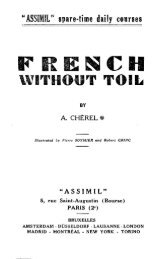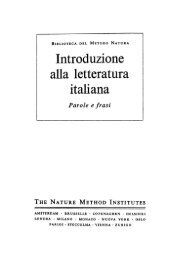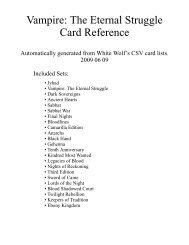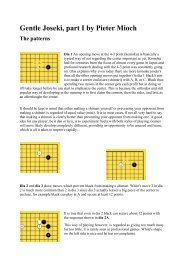Plains Cree: A Grammatical Study - Computer Science Club
Plains Cree: A Grammatical Study - Computer Science Club
Plains Cree: A Grammatical Study - Computer Science Club
Create successful ePaper yourself
Turn your PDF publications into a flip-book with our unique Google optimized e-Paper software.
WOLFART: PLAINS CREE<br />
10 [TRANS. AMER. PHIL. SOC.<br />
MAP. 3. Distribution of <strong>Cree</strong> groups.<br />
--- Approximate distribution of <strong>Cree</strong>-speaking grol ups 1970.<br />
- <strong>Plains</strong> <strong>Cree</strong> (culturally defined; after Mandelb; aum) 1860.<br />
TH: Woods <strong>Cree</strong> at Lac La Ronge, Saskatchewan<br />
and in Rupert's Land (between the lower courses of<br />
the Nelson and Churchill Rivers).<br />
N: Swampy <strong>Cree</strong>, in a broad belt from Cumberland<br />
House, Saskatchewan (just west of The Pas, Mani-<br />
toba) to the coast of Hudson Bay and James Bay,<br />
from the Nelson River in the north to the Albany<br />
River in the south.10<br />
L: Moose <strong>Cree</strong>, spoken at Moose Factory (Mooso-<br />
min), Ontario and in the lower portion of the Moose<br />
River drainage.<br />
1.23. <strong>Plains</strong> <strong>Cree</strong><br />
The <strong>Plains</strong> <strong>Cree</strong> dialect which forms the basis of<br />
the present study is spoken primarily in the central<br />
part of Alberta and in the central and southern parts<br />
of Saskatchewan. Since language-based figures do<br />
not exist, we can only cite Canadian government<br />
sourcesll which indicate a total of about 26,000 <strong>Plains</strong><br />
<strong>Cree</strong> and 12,000 other <strong>Cree</strong> in Alberta and Saskatche-<br />
10 Ellis's Spoken <strong>Cree</strong> (1962) and '<strong>Cree</strong> Verb Paradigms" (1971)<br />
are composite treatments of the n-dialect of Fort Albany and the<br />
i-dialect of Moose Factory; in Ellis, 1962 the text shows I and the<br />
tapes, n In the present study, the dialect(s) described by Ellis is<br />
referred to as James Bay <strong>Cree</strong> and cited with n.<br />
11 Canada, 1970. These figures are based on cultural affiliation<br />
and other criteria and are not to be relied on as guides to dialect<br />
or even language assignment.<br />
,'p % 19-^ 70.B%<br />
wan.'2 These figures reflect only "treaty Indians"<br />
not all of whom necessarily still speak <strong>Cree</strong>; on the<br />
other hand, they ignore the large iumber of non-<br />
treaty Indians and Metis many of whom do speak<br />
<strong>Cree</strong>, so that they may be useful as a gross estimate<br />
after all.<br />
The historical movement of the <strong>Plains</strong> <strong>Cree</strong> from<br />
their seventeenth-century location in an area bounded<br />
by Lake Superior, Lake Winnipeg, and Hudson Bay,<br />
to the western <strong>Plains</strong> and the foot of the Rocky<br />
Mountains has been described in great detail by<br />
Mandelbaum (1940). Mlandelbaum's chief concern<br />
is the dramatic change, brought on by the fur trade,<br />
from the aboriginal woodlands culture to that of the<br />
<strong>Plains</strong>; but the texts even of today bear eloquent<br />
witness to the woodlands heritage, as for instance in<br />
the Windigo stories.<br />
Map 3 shows the range of the <strong>Plains</strong> <strong>Cree</strong> (cultur-<br />
ally defined; after Mandelbaum, 1940) in the 1860's;<br />
it also indicates the approximate distribution of <strong>Cree</strong>-<br />
speaking groups at present (after Canada, 1970).<br />
12 In 1874 Lacombe had estimated the number of <strong>Plains</strong> <strong>Cree</strong><br />
as 15,000 to 16,000 (1874a: p. x). These figures would seem to<br />
fit the estimate of Chafe (1962: p. 165) who gives a figure of<br />
30,000 to 40,000 for all <strong>Cree</strong> (and 5,000 for Montagnais-Naskapi).<br />
According to government sources for 1970 (Canada, 1970) there<br />
are about 16,000 <strong>Cree</strong> in Manitoba and another 16,000 in Ontario<br />
and Quebec, bringing the total to about 70,000.









